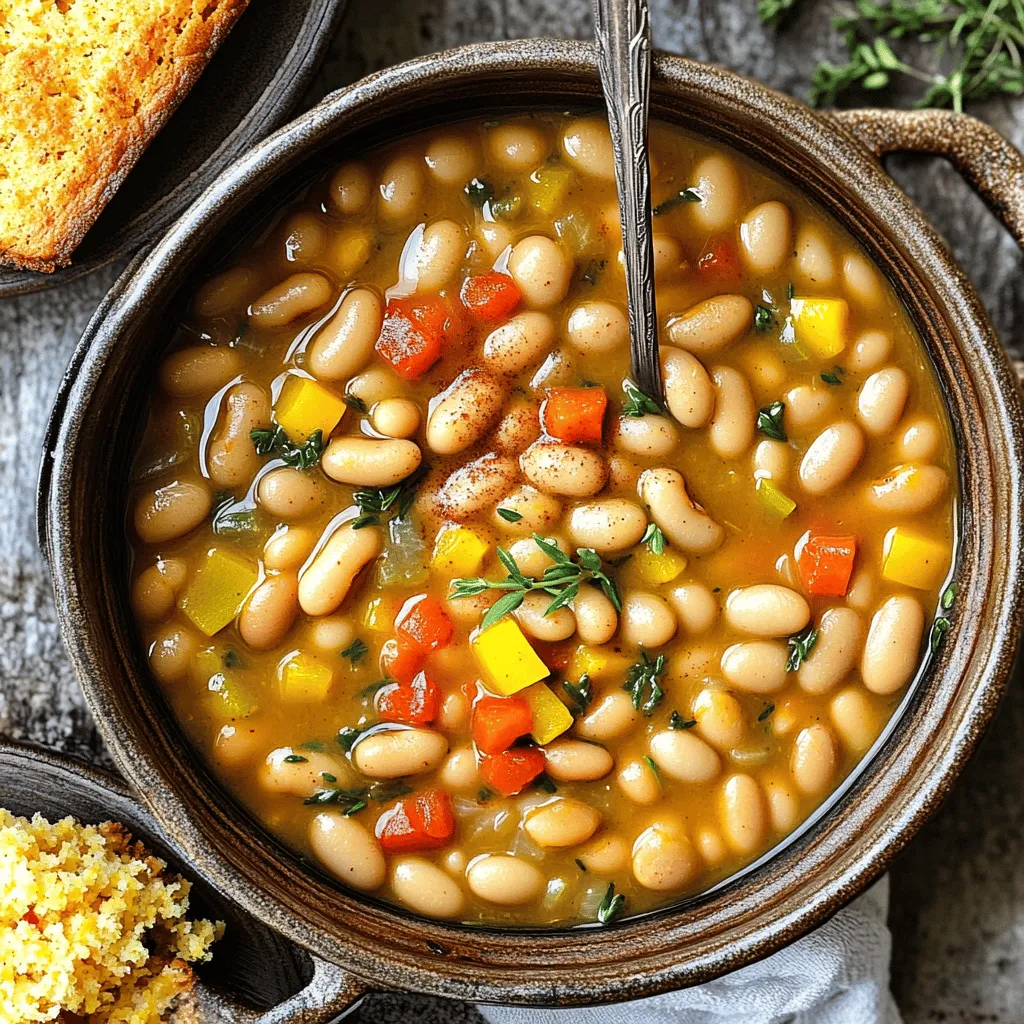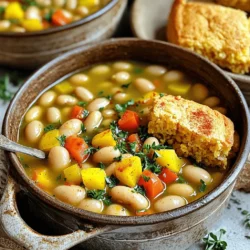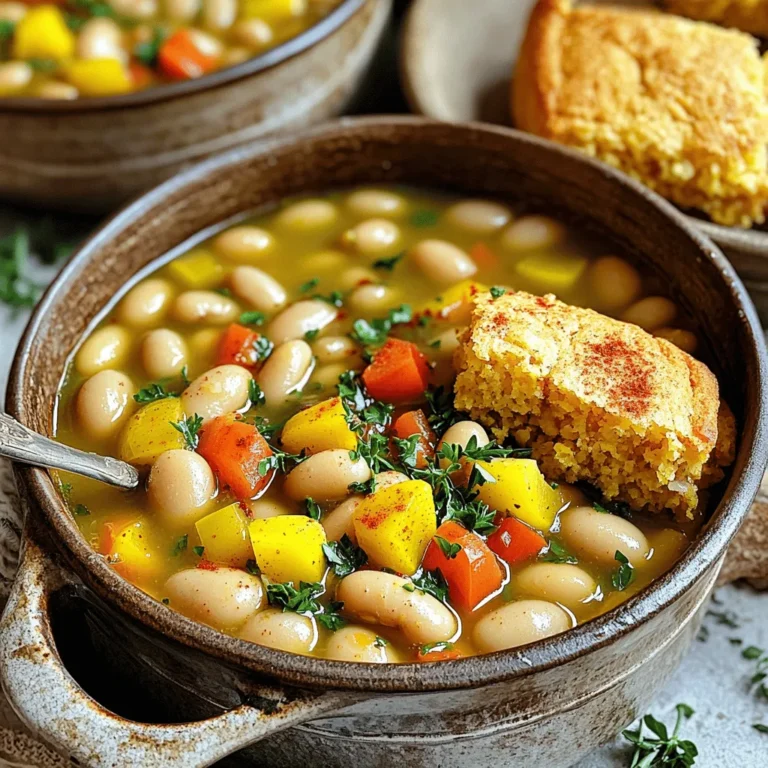Southern Homemade Butter Beans are a true comfort food! In this post, I’ll show you how to make these creamy, delicious beans that your family will love. We’ll dive deep into choosing the best ingredients, soaking and cooking beans, and even share tips and tricks for perfecting your dish. Plus, I’ll answer common questions to ensure your butter beans turn out great every time. Let’s get cooking!
Ingredients
Fresh Produce Selection
Choosing quality ingredients is key for great butter beans. Fresh produce enhances flavor and texture. Look for firm, plump butter beans. They should feel smooth and not have any dark spots.
When selecting butter beans, check local farmers’ markets or grocery stores. Some brands offer dried beans that are fresh and flavorful. Look for organic options if you can. They often taste better and are grown without harmful chemicals.
Complete Ingredient List
- 2 cups dried butter beans (also known as lima beans)
- 6 cups water (for soaking and cooking)
- 1 tablespoon olive oil
- 1 medium onion, diced
- 2 cloves garlic, minced
- 1 bell pepper, diced (any color)
- 2 teaspoons smoked paprika
- 1 teaspoon thyme (fresh or dried)
- 1 bay leaf
- Salt and pepper to taste
- 4 cups vegetable broth
- 1/4 cup fresh parsley, chopped (for garnish)
These ingredients combine to create a creamy and delicious dish. Each one plays a part in building deep flavors. For the best outcome, gather everything before you start cooking.
Step-by-Step Instructions
Soaking the Beans
Soaking is important for dried butter beans. It helps them cook evenly and become tender. I recommend soaking them overnight or for at least 8 hours. This also helps reduce cooking time.
After soaking, drain and rinse the beans. This step removes any dirt or impurities.
Cooking Process
Start by sautéing the aromatics. Heat olive oil in a large pot over medium heat. Add the diced onion and cook until it’s soft and clear. This takes about 5 minutes. Then, stir in the minced garlic and diced bell pepper. Cook for 2-3 more minutes until fragrant.
Next, add the spices. Sprinkle in the smoked paprika and thyme. Stir to coat the veggies well. Cook for another minute to release the spice aromas.
Now, combine the soaked butter beans with vegetable broth and the bay leaf. Bring this mixture to a boil. Once boiling, reduce the heat to low. Cover the pot and let it simmer for 45-60 minutes. The beans should be tender when done. Stir occasionally and add more broth if it gets too thick.
Final Touches
Once the beans are tender, remove the bay leaf. Season to taste with salt and pepper. For a creamier texture, mash a few beans against the pot’s side. This gives a smooth finish to your dish.
Garnish with fresh parsley before serving. This adds a pop of color and flavor. Enjoy your butter beans hot, and pair them with cornbread or rice for a true Southern meal.
Tips & Tricks
Cooking Techniques
Managing Cooking Times
Cooking butter beans takes patience. Aim for about 45 to 60 minutes of simmering. Check the beans often. You want them soft but not mushy. If they are too firm, let them cook longer. If they are too soft, you may have overcooked them. Always consider the size of the beans and the heat level.
Adjusting Consistency
If your butter beans are too thick, add a splash of broth or water. Stir well and let it simmer for a few more minutes. For a creamier dish, mash a few beans against the pot’s side. This releases starch and thickens the mix naturally.
Flavor Enhancements
Using Broth vs. Water
Using vegetable broth boosts the flavor of your butter beans. Water is okay but lacks depth. Broth gives your dish a rich taste. Always choose low-sodium broth to control salt levels.
Incorporating Additional Vegetables or Proteins
Feel free to add more veggies like carrots or celery. You can also mix in proteins such as ham or sausage. This adds texture and flavor to your dish. Each extra ingredient can lift the overall taste.
Common Mistakes to Avoid
Overcooking or Undercooking Beans
It’s easy to overcook beans. This makes them mushy and bland. Undercooked beans can be hard and tough. Keep an eye on the cooking time to find the sweet spot.
Skipping Flavoring Steps
Don’t skip aromatics like garlic and onion. They form the base of your flavor. Adding spices like smoked paprika and thyme is also key. Each step builds a delicious profile for your butter beans.
Variations
Regional Adaptations
Southern butter beans shine with their creamy texture and rich taste. Other regions have their own takes on these beans. In the South, we often use smoked paprika and fresh thyme. In contrast, Northern styles might feature more herbs like rosemary.
You can also add local ingredients to your butter beans. For example, in Louisiana, folks love to add andouille sausage for a spicy kick. In Texas, a touch of jalapeño offers heat. These local flavors make each dish unique.
Dietary Modifications
If you want a vegetarian dish, butter beans are perfect. They pack protein and fiber, making them filling. Just skip any meat and use vegetable broth instead of chicken broth. This keeps your dish hearty without losing flavor.
For gluten-free meals, butter beans fit right in. They are naturally gluten-free, so you don’t need to change much. Just be sure to check your broth and spices for any hidden gluten.
Creative Serving Suggestions
Pair your butter beans with classic Southern sides. Cornbread is a must. It soaks up the creamy sauce well. You can also serve them over rice for a comforting meal.
Got leftovers? Transform them into something new! You can mash them into a spread for sandwiches. Or mix them with cooked grains and veggies for a salad. The options are endless, making butter beans a versatile dish.

Storage Info
Proper Storage Techniques
- Refrigeration Tips: After cooking, let the butter beans cool down. Store them in an airtight container. They will last in the fridge for about 3 to 5 days. If you want them to stay fresher, add a bit of olive oil before sealing.
- Freezing for Long-Term Storage: You can freeze butter beans for up to six months. First, let the beans cool completely. Then, place them in freezer bags. Remove as much air as possible before sealing. Label the bags with the date for easy tracking.
Reheating Instructions
- Best Methods to Maintain Flavor and Texture: The best way to reheat butter beans is on the stove. Place them in a pot over low heat. Stir often and add a splash of water or broth to keep them moist. You can also use the microwave, but be careful not to dry them out.
- Time and Temperature Guidelines: If you’re using the stove, it takes about 10 minutes to heat through. For the microwave, start with 2 minutes on high, then stir and check. Add more time as needed until they are hot.
FAQs
What are the health benefits of butter beans?
Butter beans are packed with nutrients. They are high in protein and fiber. A one-cup serving has about 200 calories, 14 grams of protein, and 9 grams of fiber. They help keep you full and support digestion. Butter beans are also low in fat. They fit well in a balanced diet, especially for vegetarians.
Can I use canned butter beans instead of dried?
Yes, you can. Canned butter beans save time. They are already cooked, so they reduce your cooking time significantly. However, they may have added salt. Rinse them well to remove excess sodium. Adjust your cooking time to about 10 minutes.
How to make butter beans creamier?
To achieve a creamier texture, mash some of the beans against the pot. You can also blend a portion of the beans with a bit of broth. If you want more creaminess, add a splash of milk or cream. For dairy-free options, try coconut milk.
What dishes pair well with butter beans?
Butter beans go great with many Southern dishes. They pair well with cornbread, collard greens, or fried chicken. Their creamy texture complements spicy flavors. You can also serve them over rice or mix with grilled vegetables for a complete meal.
In this blog post, we explored how to choose fresh butter beans and other key ingredients for a great dish. I shared step-by-step instructions on soaking, cooking, and seasoning your beans perfectly. We discussed tips to enhance flavor, common mistakes to avoid, and creative ways to serve your beans. Proper storage and reheating methods will keep your meals fresh. Remember, butter beans are not just healthy but versatile too. Enjoy your cooking adventure and experiment with new flavors!


